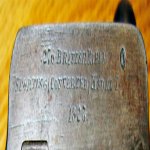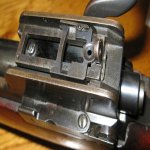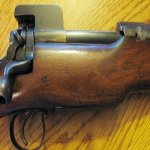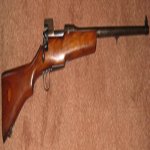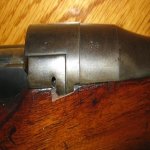- Location
- Western Manitoba
Perhaps I am mistaken in some this below - I would appreciate to be corrected, if I am in error. Most of this comes from various reference books here - most of it by Charles R. Stratton - Volume 4, 2nd Edition, British Enfield Rifles - "Pattern 1914 and U.S. Model of 1917".
I have received a few requests or inquiries about a part for "a" P14 rifle - is different than "modern" made guns for sure - apparently those guns were made at three different factories in USA, owned by three separate owners - and no blue-prints provided in the contracts with Britain - so each version differs a bit from the other - each factory designer had to come up with something to specify to their production line or their sub-contractors for parts - and not all were the same to each other. That was the P14 Mark I. After a few months production, there was a requirement to slightly lengthen the left side (top) bolt lug - this required an annular groove to be cut into the rear face of the barrel - around the chamber - to give clearance for that longer bolt lug. So, that was the Mark I * version - so was 6 versions coming out of USA factories during WWI. Then, most, but not all, were "re-built", in Britain, shortly before or during start of WWII - using parts (especially the long stocks and the hand guards) provided by British sub-contractors - so is potentially 12 variations of "a" milsurp P14 rifle - some parts interchange among all of them, and some parts do not - there are north of 80 parts to make up one rifle. As per that Stratton book, there are also some parts from an SMLE and from a "P17" that will also interchange to a P14 - but the markings are supposed to be different.
That Stratton book gives a listing of various parts that the British War Office declared to be "not interchangeable" - as I understand it, the WWI British Armourers did not want to "hand fit" a part for a rifle under repair - that meant the same modification would be required for each subsequent repair of that gun - they wanted "drop-in" replacement parts. So, some of the "not interchangeable" parts on that list actually do interchange - it might have been a tolerance thing that was different between one maker and another, although some parts are drastically different shape, and most definitely not interchangeable - for example, the Winchester made receiver has a slot cut underneath - to accept a "lip" at the top front of the Winchester made magazine box - neither the Eddystone nor the Remington receivers have that slot - so you are NOT going to "drop in" a "W" magazine box to work on a "R" receiver rifle; similar with the magazine follower - the "W" made one is very different shape than those made by "E" or "R".
As I read, after a couple of years, the British Industry "caught up" making machine guns and rifles - so those contracts with USA makers were cancelled. About that time, the USA decided to get involved with WWI in Europe - however not near enough Springfield 1903 rifles in existence to field an American Army to Europe - so those three factories and their labour force, were quickly "converted" to produce a modified P14 that would fire the American 30-06 cartridge - several million of those were made - informally referred to in those factories as "P17" to differentiate from the 303 British P14 rifles. Many parts interchange, but not all.
It is to be noted that the P14 was designed at the Enfield Armoury in Britain, and it might be possible that they produced perhaps up to 100 rifles. The "P14" itself, was a "hurry up" conversion from the earlier P13 rifle, which fired a much larger .276 Enfield cartridge - but with advent of WWI, any plans that Britain had for standardizing on .276 Enfield instead of 303 British were abandoned, and that rifle design was converted over to use the standard 303 British round - so the rifle, generally, is much larger and stronger than strictly needed for 303 British cartridge - hence made for "easier" adaptation in USA to use the American 30-06 round.
I have received a few requests or inquiries about a part for "a" P14 rifle - is different than "modern" made guns for sure - apparently those guns were made at three different factories in USA, owned by three separate owners - and no blue-prints provided in the contracts with Britain - so each version differs a bit from the other - each factory designer had to come up with something to specify to their production line or their sub-contractors for parts - and not all were the same to each other. That was the P14 Mark I. After a few months production, there was a requirement to slightly lengthen the left side (top) bolt lug - this required an annular groove to be cut into the rear face of the barrel - around the chamber - to give clearance for that longer bolt lug. So, that was the Mark I * version - so was 6 versions coming out of USA factories during WWI. Then, most, but not all, were "re-built", in Britain, shortly before or during start of WWII - using parts (especially the long stocks and the hand guards) provided by British sub-contractors - so is potentially 12 variations of "a" milsurp P14 rifle - some parts interchange among all of them, and some parts do not - there are north of 80 parts to make up one rifle. As per that Stratton book, there are also some parts from an SMLE and from a "P17" that will also interchange to a P14 - but the markings are supposed to be different.
That Stratton book gives a listing of various parts that the British War Office declared to be "not interchangeable" - as I understand it, the WWI British Armourers did not want to "hand fit" a part for a rifle under repair - that meant the same modification would be required for each subsequent repair of that gun - they wanted "drop-in" replacement parts. So, some of the "not interchangeable" parts on that list actually do interchange - it might have been a tolerance thing that was different between one maker and another, although some parts are drastically different shape, and most definitely not interchangeable - for example, the Winchester made receiver has a slot cut underneath - to accept a "lip" at the top front of the Winchester made magazine box - neither the Eddystone nor the Remington receivers have that slot - so you are NOT going to "drop in" a "W" magazine box to work on a "R" receiver rifle; similar with the magazine follower - the "W" made one is very different shape than those made by "E" or "R".
As I read, after a couple of years, the British Industry "caught up" making machine guns and rifles - so those contracts with USA makers were cancelled. About that time, the USA decided to get involved with WWI in Europe - however not near enough Springfield 1903 rifles in existence to field an American Army to Europe - so those three factories and their labour force, were quickly "converted" to produce a modified P14 that would fire the American 30-06 cartridge - several million of those were made - informally referred to in those factories as "P17" to differentiate from the 303 British P14 rifles. Many parts interchange, but not all.
It is to be noted that the P14 was designed at the Enfield Armoury in Britain, and it might be possible that they produced perhaps up to 100 rifles. The "P14" itself, was a "hurry up" conversion from the earlier P13 rifle, which fired a much larger .276 Enfield cartridge - but with advent of WWI, any plans that Britain had for standardizing on .276 Enfield instead of 303 British were abandoned, and that rifle design was converted over to use the standard 303 British round - so the rifle, generally, is much larger and stronger than strictly needed for 303 British cartridge - hence made for "easier" adaptation in USA to use the American 30-06 round.
Last edited:















































